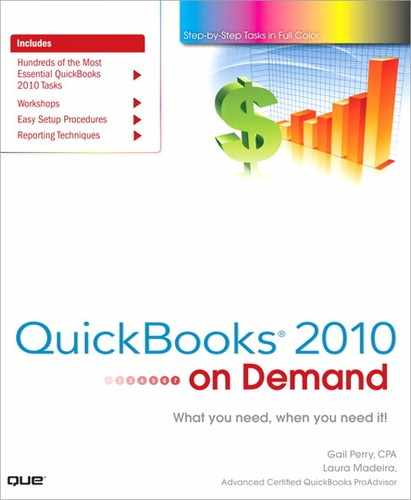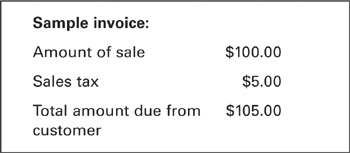4. Invoicing and Collecting Income
Having a method for recording your income is likely one of the main reasons you purchased your QuickBooks program. Here are just some of the reasons why it’s important to have an accurate record of your income transactions.
• You need to be able to track your company’s revenue and record income transactions so you know how well your company is performing.
• You need a process to separate your income into appropriate accounts so that you can produce reliable financial statements that tell you where your company’s strengths and weaknesses are.
• You need the record-keeping ability necessary to provide your customers with an opportunity to make down payments and partial payments, as well as being able to give them the right to receive refunds and credits for returned merchandise or unfulfilled obligations.
• You need to properly track and record the dollar amount you deposit in your bank account.
• You need the convenience of sending an email invoice to your customers.
• If you incur expenses on behalf of a customer, you need to be able to charge those expenses to your customer.
• You need to be able to assess finance charges for late payments.
All of this and more can be accomplished through the invoicing and collection services available in your QuickBooks program. This chapter explains how you can meet all your revenue-collection obligations.
Setting Customers Preferences
You can customize some of the standard features that apply to invoices by making adjustments in the Sales & Customers preferences screen. The types of preferences that relate to your sales operations include setting a default shipping method, setting a standard markup percent for items you purchase and resell to customers, and indicating a standard FOB for your company. In addition, you indicate how you want reimbursements to be recorded in your financial records, in what order customer payments are to be applied to outstanding invoices, whether you want to be told you are about to issue a duplicate invoice number, and whether you want to use the QuickBooks Price Level feature. The QuickBooks Price Level feature enables you to easily apply discounts or price increases to items on your invoices. The settings you make here affect all your company’s invoices. Note that only a user with administrative rights can make changes to the company preferences for sales and customers.
Set Payments Preferences
![]() Select Edit, Preferences.
Select Edit, Preferences.
![]() Click the Payments icon.
Click the Payments icon.

![]() Click the Company Preferences tab.
Click the Company Preferences tab.
![]() Click on the Explain link to learn more about Integrated Payment Processing.
Click on the Explain link to learn more about Integrated Payment Processing.
![]() Check Automatically Apply Payments if you want QuickBooks to apply customer payments to outstanding invoices.
Check Automatically Apply Payments if you want QuickBooks to apply customer payments to outstanding invoices.
![]() Check Automatically Calculate Payments if you want to automatically calculate the amount of payments you received based on the invoices you check off on the Receive Payments list.
Check Automatically Calculate Payments if you want to automatically calculate the amount of payments you received based on the invoices you check off on the Receive Payments list.
![]() Check Use Undeposited Funds As a Default Deposit to Account to designate your undeposited funds account as the default account when recording payments that you receive.
Check Use Undeposited Funds As a Default Deposit to Account to designate your undeposited funds account as the default account when recording payments that you receive.
![]() Click OK.
Click OK.
Set Sales and Customers Preferences
![]() Select Edit, Preferences.
Select Edit, Preferences.
![]() Click the Sales & Customers icon.
Click the Sales & Customers icon.
![]() Click the Company Preferences tab.
Click the Company Preferences tab.
![]() In the Sales Forms pane, indicate the Usual Shipping Method and Usual FOB, and place a check mark to Warn About Duplicate Invoice Numbers.
In the Sales Forms pane, indicate the Usual Shipping Method and Usual FOB, and place a check mark to Warn About Duplicate Invoice Numbers.
![]() In the Miscellaneous pane, indicate a default packing slip template.
In the Miscellaneous pane, indicate a default packing slip template.
![]() Check Use Price Levels to use the QuickBooks Price Levels feature for quickly adjusting amounts on sales forms by a preset percentage.
Check Use Price Levels to use the QuickBooks Price Levels feature for quickly adjusting amounts on sales forms by a preset percentage.
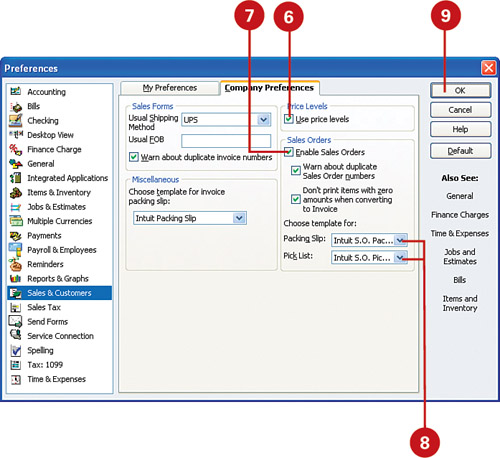
![]() Check Enable Sales Orders if you want to use the sales orders feature in QuickBooks. If you check this box, you have the option of checking the box to warn about duplicate sales order numbers and to prevent the printing of zero amounts.
Check Enable Sales Orders if you want to use the sales orders feature in QuickBooks. If you check this box, you have the option of checking the box to warn about duplicate sales order numbers and to prevent the printing of zero amounts.
![]() If you have enabled sales orders, choose the templates you prefer to use for sales order packing slips and sales order pick lists.
If you have enabled sales orders, choose the templates you prefer to use for sales order packing slips and sales order pick lists.
![]() Click OK.
Click OK.
Creating an Invoice
The invoice is the basic form you use to charge your customers for goods and services. Invoices include detailed lists of all items that you charge to a customer. There are several types of invoice forms available in QuickBooks. Choose the form that best suits the type of business you do. You can use the invoice form as a document that you give or send to your customers, or you can use the form purely for internal purposes, to record sales that occur in your company.
![]() Select Customers, Create Invoices.
Select Customers, Create Invoices.
Timesaver
You can also click the Invoices icon on the Home page, or press Ctrl+I to start a new invoice.
![]() Select a customer and, if applicable, a job from the Customer:Job drop-down list.
Select a customer and, if applicable, a job from the Customer:Job drop-down list.
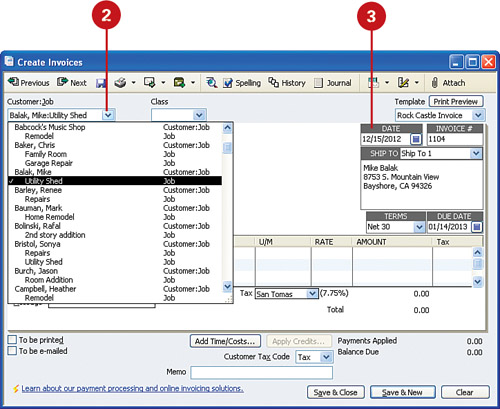
![]() Verify that the date is correct, making any necessary changes.
Verify that the date is correct, making any necessary changes.
![]() Click the Template drop-down menu if you want to choose a different style of invoice.
Click the Template drop-down menu if you want to choose a different style of invoice.
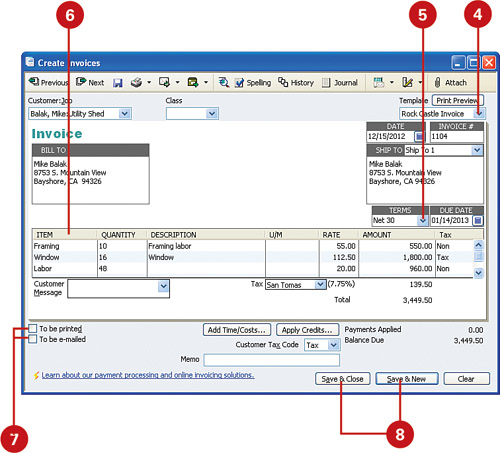
![]() Enter the terms that apply to this customer.
Enter the terms that apply to this customer.
![]() Enter each of the items that this customer is purchasing, along with quantities and rates. (The rates might appear automatically, depending on how the items are entered in your records.) The Amount column is automatically calculated.
Enter each of the items that this customer is purchasing, along with quantities and rates. (The rates might appear automatically, depending on how the items are entered in your records.) The Amount column is automatically calculated.
![]() Check To Be Printed or To Be E-mailed.
Check To Be Printed or To Be E-mailed.
![]() Select a save option.
Select a save option.
Previewing or Printing Invoices
When it’s time to send your invoice to a customer, it pays to first take a look at the form and double-check to make sure everything is the way you want it. After previewing the invoice, you can choose to print the form right away or save it for printing later, perhaps with a batch of other invoices.
Preview or Print a Single Invoice
![]() Prepare an invoice.
Prepare an invoice.
![]() If you want to print this invoice later with a batch of invoices, as described in the next task, check the To Be Printed box, save your invoice, and skip the rest of this task.
If you want to print this invoice later with a batch of invoices, as described in the next task, check the To Be Printed box, save your invoice, and skip the rest of this task.
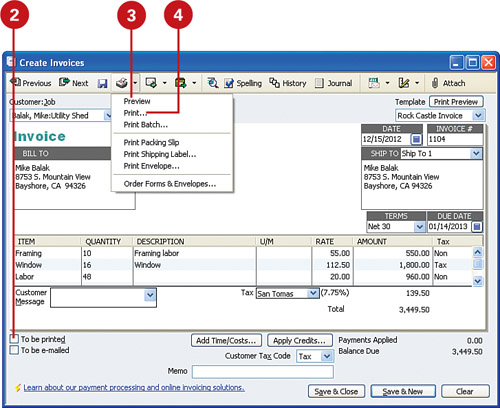
![]() To print this invoice now, click the drop-down arrow next to the Print button on the invoice form toolbar. Select Preview if you are not yet ready to print the invoice.
To print this invoice now, click the drop-down arrow next to the Print button on the invoice form toolbar. Select Preview if you are not yet ready to print the invoice.
Timesaver
You can also press Ctrl+P to print the invoice.
![]() Select Print to print the invoice.
Select Print to print the invoice.
![]() Click Print in the Print One Invoice dialog box that display.
Click Print in the Print One Invoice dialog box that display.

![]() Save your invoice.
Save your invoice.
Printing a Batch of Invoices
![]() Select File, Print Forms and then select Invoices.
Select File, Print Forms and then select Invoices.
![]() Check each invoice you want to print at this time.
Check each invoice you want to print at this time.
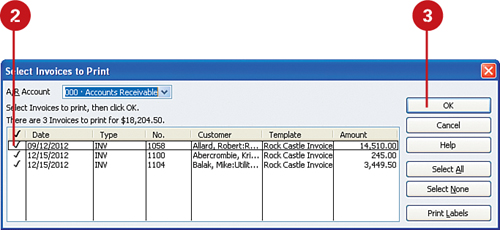
Important
You can save time by using the Select All and Select None buttons, and then checking or unchecking the invoices.
Important
You cannot make changes in this window. If you discover that the amount on an invoice is incorrect, you cannot enter a change here. Close the Select Invoices to Print window and open the original invoice, make your changes, and return to this window for printing.
![]() Click OK.
Click OK.
![]() Click the Print button in the Print Invoices dialog box.
Click the Print button in the Print Invoices dialog box.
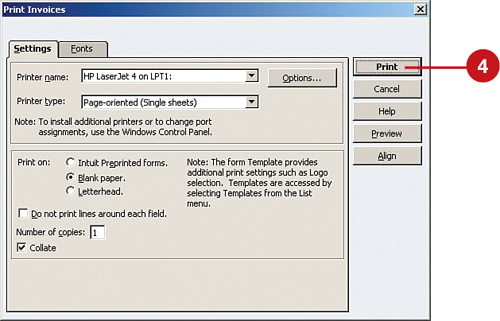
Emailing an Invoice
The most popular form of communication these days seems to be email, so why not take advantage of this medium to dispatch your invoices? Email is easy, and you can get your invoice into the hands of your customer quickly. One word of warning: Make sure your customer expects the e-invoice so your message won’t get lost in the shuffle of junk that permeates email boxes. If your customer is keen on electronic communication, you might be able to encourage an electronic payment, which reduces the turnaround time on your invoice even more.
Setting Email Preferences
![]() From the Edit menu, select Preferences.
From the Edit menu, select Preferences.
![]() Select the Send Forms menu.
Select the Send Forms menu.
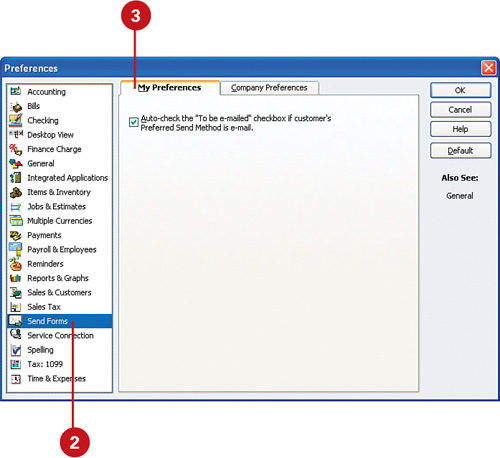
![]() On the My Preferences tab, place a check mark to Auto-check the To Be Emailed box (optional).
On the My Preferences tab, place a check mark to Auto-check the To Be Emailed box (optional).
![]() Select the Company Preferences tab.
Select the Company Preferences tab.
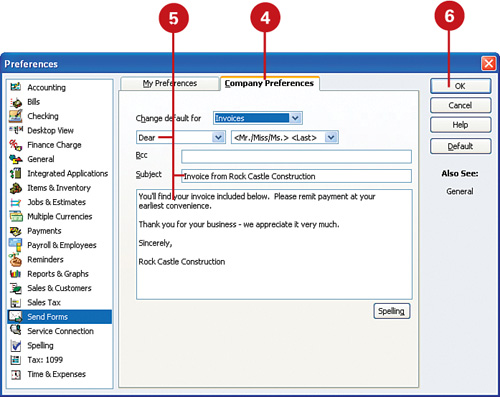
![]() Define your default salutation, subject, and generic content for your email communications.
Define your default salutation, subject, and generic content for your email communications.
![]() Click OK.
Click OK.
Indicate Email Status on an Invoice
![]() Create an invoice, or open an invoice form already created but not yet printed.
Create an invoice, or open an invoice form already created but not yet printed.
![]() Check the To Be E-mailed box to initiate email delivery.
Check the To Be E-mailed box to initiate email delivery.
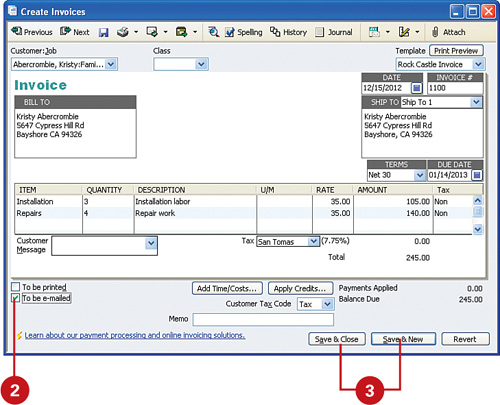
![]() Click a Save option.
Click a Save option.
![]() If the customer’s email address was not entered previously, you are prompted to enter it now.
If the customer’s email address was not entered previously, you are prompted to enter it now.
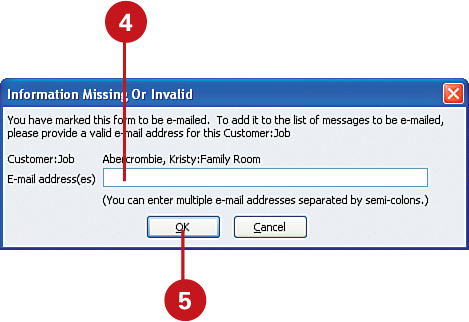
![]() Click OK.
Click OK.
Send One Invoice by Email
![]() Open the invoice on which you indicated email delivery.
Open the invoice on which you indicated email delivery.
![]() Click the drop-down arrow next to the Send button.
Click the drop-down arrow next to the Send button.
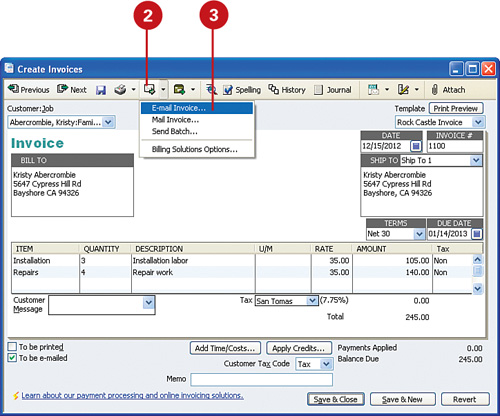
![]() Select E-mail Invoice.
Select E-mail Invoice.
![]() Verify that the information in the cover letter is correct.
Verify that the information in the cover letter is correct.

![]() Make changes or additions to the cover letter if necessary.
Make changes or additions to the cover letter if necessary.
![]() Click the Send Now button.
Click the Send Now button.
Send a Batch of Email Invoices
![]() Select File, Send Forms.
Select File, Send Forms.
![]() Click in the first column to check off each form you want to send. Check marks appear to the left of each selected form.
Click in the first column to check off each form you want to send. Check marks appear to the left of each selected form.
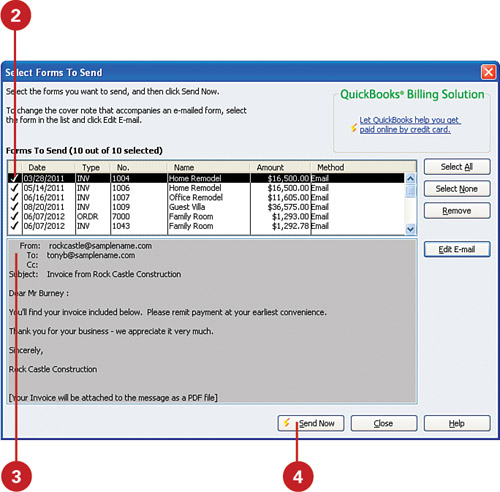
![]() Double-click any form to display a preview of the accompanying cover letter.
Double-click any form to display a preview of the accompanying cover letter.
![]() Click Send Now.
Click Send Now.
Charging Expenses to a Customer
When you make a purchase on behalf of a customer, you need to designate the customer on the bill. Then, when you create an invoice for the customer, you can request that expenses be charged, as well as any other items that go on the invoice. This is commonly referred to as time and materials billing or cost plus billing. You can also select a markup for the expense if you intend to sell this to your customer at a profit.
Designate the Customer When Making a Purchase
![]() Prepare a new bill for a purchase, or open an existing bill.
Prepare a new bill for a purchase, or open an existing bill.
![]() Enter the customer’s name and, if applicable, a job.
Enter the customer’s name and, if applicable, a job.
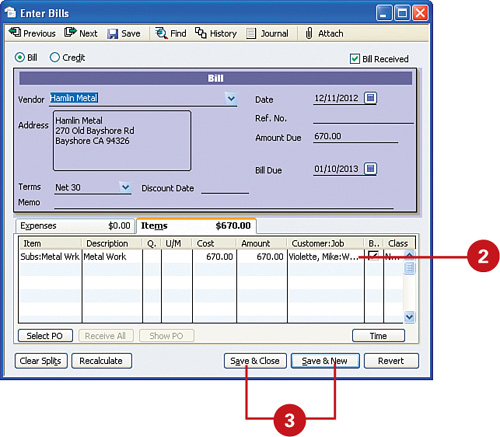
![]() Save the bill.
Save the bill.
Place Expenses on a Customer Invoice
![]() Open an invoice form and enter the customer information.
Open an invoice form and enter the customer information.
![]() If this pop-up dialog box display, choose the option to Select the Outstanding Billable Time and Costs to Add to This Invoice, and then click OK. Note that you can check a box at the bottom of the dialog box if you want to make this your default choice for future invoices that have time or costs assigned to them.
If this pop-up dialog box display, choose the option to Select the Outstanding Billable Time and Costs to Add to This Invoice, and then click OK. Note that you can check a box at the bottom of the dialog box if you want to make this your default choice for future invoices that have time or costs assigned to them.

![]() If the pop-up dialog box did not appear, click the Add Time/Costs button.
If the pop-up dialog box did not appear, click the Add Time/Costs button.
![]() Click the Expenses tab.
Click the Expenses tab.
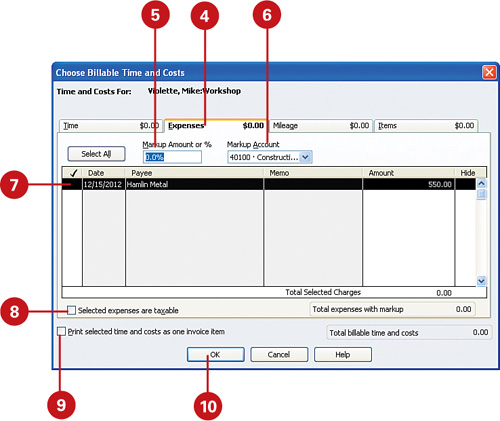
![]() Enter the markup amount or percentage, if applicable.
Enter the markup amount or percentage, if applicable.
![]() Verify the account to which the markup should be recorded, if applicable.
Verify the account to which the markup should be recorded, if applicable.
![]() Check any item you want to include on this invoice.
Check any item you want to include on this invoice.
![]() Indicate whether the expenses are taxable to the customer.
Indicate whether the expenses are taxable to the customer.
![]() If you are charging more than one item to the customer, and if you want all the items to appear as a single item on the customer invoice, check this box.
If you are charging more than one item to the customer, and if you want all the items to appear as a single item on the customer invoice, check this box.
![]() Click OK to place the selected expenses on the customer’s invoice.
Click OK to place the selected expenses on the customer’s invoice.
![]() Complete the invoice and save it.
Complete the invoice and save it.
Setting Finance Charge Preferences
Do you charge your customers a fee for late payments? If so, you can create several settings to ensure that the process of assessing finance charges is consistent and automatic. Any settings you establish here can be revised later, but you’ll save yourself time by thinking through these options and configuring the settings before you start dealing with customers who made late payments.
![]() Select Edit, Preferences.
Select Edit, Preferences.
![]() Click the Finance Charge icon.
Click the Finance Charge icon.

![]() Click the Company Preferences tab.
Click the Company Preferences tab.
![]() Indicate in the Annual Interest Rate field the amount of interest that your company charges for past-due customer payments.
Indicate in the Annual Interest Rate field the amount of interest that your company charges for past-due customer payments.
![]() Indicate in the Minimum Finance Charge field the amount, if any, that your company assesses on late payments.
Indicate in the Minimum Finance Charge field the amount, if any, that your company assesses on late payments.
![]() Enter the number of days in the Grace Period (days) field allowed before finance charges are assessed.
Enter the number of days in the Grace Period (days) field allowed before finance charges are assessed.
![]() Choose from the Finance Charge Account drop-down list the account you use to track finance charges.
Choose from the Finance Charge Account drop-down list the account you use to track finance charges.
![]() Check Assess Finance Charges on Overdue Finance Charges if you add previous finance charges to the balance when computing additional finance charges.
Check Assess Finance Charges on Overdue Finance Charges if you add previous finance charges to the balance when computing additional finance charges.
![]() Select an option in the Calculate Charges From section.
Select an option in the Calculate Charges From section.
![]() Check Mark Finance Charge Invoices “To Be Printed” if you want to send an invoice to customers when finance charges are assessed. If you check this box, QuickBooks automatically places the finance charge invoices in your printer queue.
Check Mark Finance Charge Invoices “To Be Printed” if you want to send an invoice to customers when finance charges are assessed. If you check this box, QuickBooks automatically places the finance charge invoices in your printer queue.
![]() Click OK.
Click OK.
Creating a Monthly Statement
It’s not unusual to have some customers who don’t pay their invoices on time. If you have customers like this, you probably want to send them a reminder that they owe you money. The monthly statement lists outstanding invoices and also provides you with an opportunity to assess a finance charge.
![]() Select Customers, Create Statements.
Select Customers, Create Statements.
Timesaver
Clicking the Statements icon on the Home page also opens the Create Statements dialog.
![]() Indicate the date that will appear on the statement.
Indicate the date that will appear on the statement.
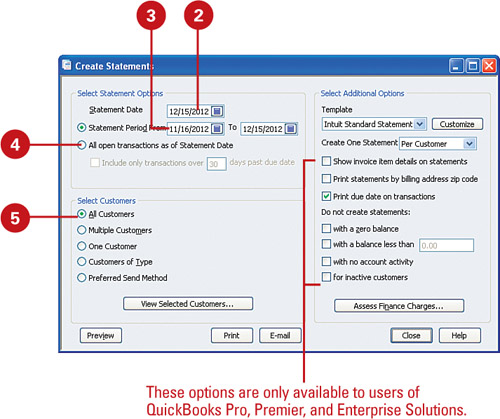
![]() Choose dates in the Statement Period From fields, or choose All Open Transactions as of Statement Date to create a statement for all outstanding invoices.
Choose dates in the Statement Period From fields, or choose All Open Transactions as of Statement Date to create a statement for all outstanding invoices.
![]() If you choose to prepare statements for all outstanding invoices, check this box to limit the statements to invoices more than a designated number of days overdue.
If you choose to prepare statements for all outstanding invoices, check this box to limit the statements to invoices more than a designated number of days overdue.
![]() Select the customers who will receive statements. If you select any option other than All Customers, you can then select the specific customers who will receive statements.
Select the customers who will receive statements. If you select any option other than All Customers, you can then select the specific customers who will receive statements.
![]() Select a template to use for the statements from the Template drop-down list.
Select a template to use for the statements from the Template drop-down list.

![]() Choose between creating one statement per customer or one statement per job.
Choose between creating one statement per customer or one statement per job.
![]() Check Show Invoice Item Details on Statements to provide detailed information from the invoice(s) on the statement.
Check Show Invoice Item Details on Statements to provide detailed information from the invoice(s) on the statement.
![]() Choose to print statements by billing address ZIP Code.
Choose to print statements by billing address ZIP Code.
![]() Check options under the Do Not Create Statements heading to customize the selection of which customers receive statements.
Check options under the Do Not Create Statements heading to customize the selection of which customers receive statements.
![]() Click Print or E-mail.
Click Print or E-mail.
Receiving Payments for Invoices
You’ve received a check from a customer! Now you need to record the payment and indicate that the invoice has been paid. Doing so clears your accounts receivable account and places the funds in an undeposited funds holding area in your QuickBooks file until you deposit the funds. When you actually deposit the money, the undeposited funds account is cleared and cash is increased.
![]() Select Customers, Receive Payments.
Select Customers, Receive Payments.
Timesaver
Click the Receive Payments icon on the Home page to go immediately to the Receive Payments dialog box.
![]() Enter the customer’s name in the Received From field.
Enter the customer’s name in the Received From field.
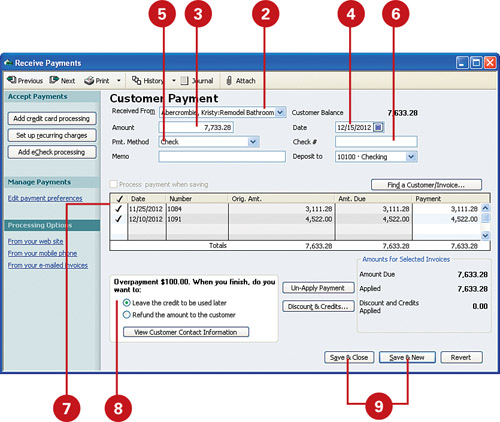
![]() Enter the amount received.
Enter the amount received.
![]() Confirm the date on which the payment was received.
Confirm the date on which the payment was received.
![]() Enter the payment method.
Enter the payment method.
![]() Enter the check number or other applicable reference number.
Enter the check number or other applicable reference number.
![]() Verify that the amounts are applied appropriately to the outstanding invoices by checking the invoices in order of how the payment will be applied.
Verify that the amounts are applied appropriately to the outstanding invoices by checking the invoices in order of how the payment will be applied.
![]() If the full amount owing has not been paid, indicate whether you want the remainder to be left as an underpayment or written off as either a discount or uncollectible.
If the full amount owing has not been paid, indicate whether you want the remainder to be left as an underpayment or written off as either a discount or uncollectible.
![]() Click a save option.
Click a save option.
Issuing a Credit or Refund
If a customer returns an item or if for any other reason you need to issue a credit or a refund to a customer, you can do so easily. You are given room to fully describe the reason for the credit or refund, and you can indicate whether tax applies to the amount.
![]() Select Customers, Create Credit Memos/Refunds, or click the Refunds & Credits icon on the Home page.
Select Customers, Create Credit Memos/Refunds, or click the Refunds & Credits icon on the Home page.
![]() Enter the customer’s name and, if applicable, the job to which this credit or refund relates in the Customer:Job field.
Enter the customer’s name and, if applicable, the job to which this credit or refund relates in the Customer:Job field.
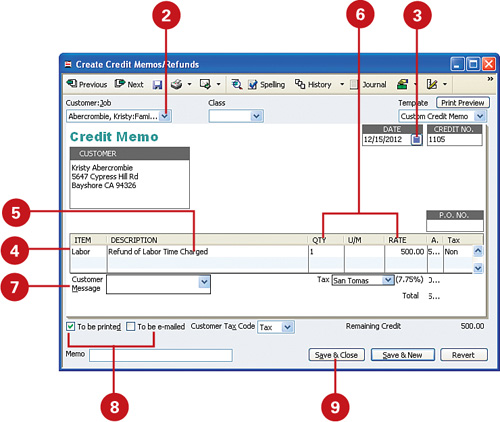
![]() Verify that the date is correct.
Verify that the date is correct.
![]() Enter the item for which the credit or refund is being issued.
Enter the item for which the credit or refund is being issued.
![]() Describe the reason for the credit or refund.
Describe the reason for the credit or refund.
![]() Enter the quantity, and, if applicable, the rate.
Enter the quantity, and, if applicable, the rate.
![]() Enter an optional customer message. If you have not used this message before, you will be prompted to add the message to your message list. Click Quick Add to add the message.
Enter an optional customer message. If you have not used this message before, you will be prompted to add the message to your message list. Click Quick Add to add the message.
![]() Indicate if you want to print the credit memo or send it by email. (These two options are not mutually exclusive—you can do both if you want.)
Indicate if you want to print the credit memo or send it by email. (These two options are not mutually exclusive—you can do both if you want.)
![]() Save the credit memo.
Save the credit memo.
![]() If the Available Credit window display, select an option to indicate how you want the credit to be treated. If you choose to apply the credit to an invoice, you will see a list of open invoices for this customer, and you can select the invoice(s) on which the credit should be applied.
If the Available Credit window display, select an option to indicate how you want the credit to be treated. If you choose to apply the credit to an invoice, you will see a list of open invoices for this customer, and you can select the invoice(s) on which the credit should be applied.
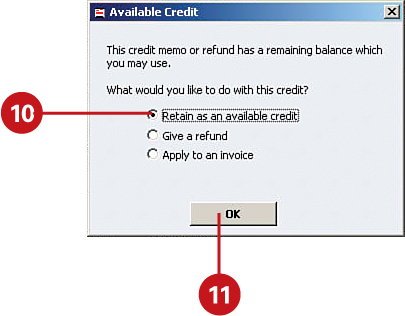
![]() Click OK.
Click OK.
Recording Cash Sales (COD)
Companies that make cash sales need to record these sales, just as companies that issue invoices record their sales. If yours is a cash business, such as a retail store, you might not keep a list of all of your customers. For sales to anonymous customers, you can create a customer and name it something such as Cash Customer or simply Customer and still record your sales properly in QuickBooks.
![]() Select Customers, Enter Sales Receipts, or click the Create Sales Receipts icon on the Home page.
Select Customers, Enter Sales Receipts, or click the Create Sales Receipts icon on the Home page.
![]() Enter a generic name for the cash customer in the Customer:Job field.
Enter a generic name for the cash customer in the Customer:Job field.
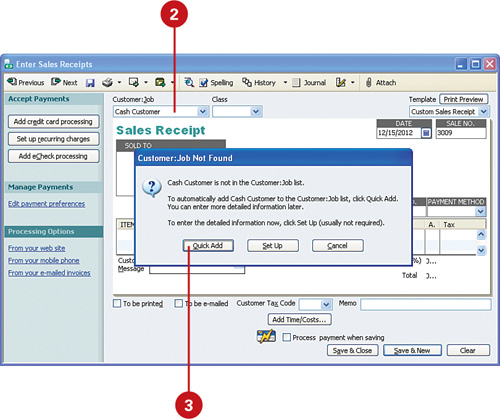
![]() Select Quick Add to add this name to your customer list if the name has not been used previously.
Select Quick Add to add this name to your customer list if the name has not been used previously.
![]() Verify the date of the sale.
Verify the date of the sale.
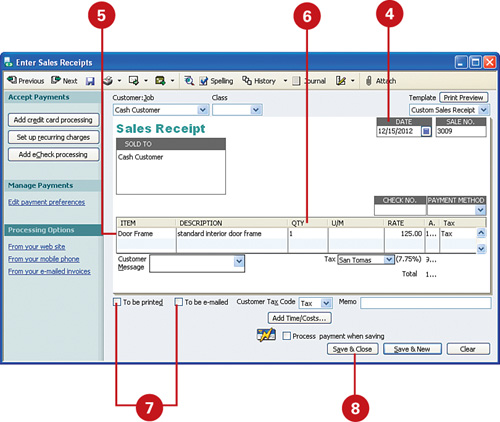
![]() Enter the item(s) sold.
Enter the item(s) sold.
![]() Enter the quantity and rate.
Enter the quantity and rate.
![]() Indicate if you want the invoice to be printed or emailed, or you can choose to print the invoice now by clicking the Print button at the top of the form.
Indicate if you want the invoice to be printed or emailed, or you can choose to print the invoice now by clicking the Print button at the top of the form.
![]() Save the form.
Save the form.
Making Bank Deposits
In the Sales & Customers preferences, you have the option of choosing whether you want payments to be routed to an undeposited funds account for future depositing instead of being recorded immediately as deposits. If you’ve chosen to deposit the funds later, you need to follow these steps to record the actual deposit.
![]() Select Banking, Make Deposits, or click the Record Deposits icon on the Home page.
Select Banking, Make Deposits, or click the Record Deposits icon on the Home page.
![]() Change the payment type if you want to view a particular type of payment (such as only cash or only MasterCard and Visa).
Change the payment type if you want to view a particular type of payment (such as only cash or only MasterCard and Visa).
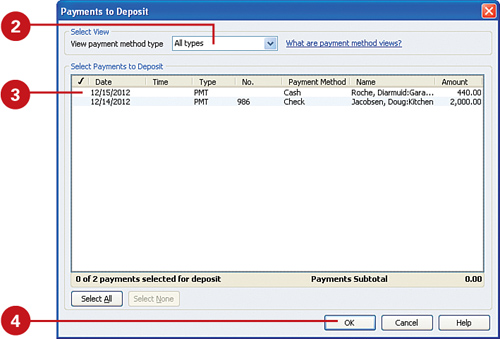
![]() Check off each of the deposits you want to make at this time. You can use the Select All button to check off the entire list at once.
Check off each of the deposits you want to make at this time. You can use the Select All button to check off the entire list at once.
![]() Click OK.
Click OK.
![]() Verify the account to which the money will be deposited.
Verify the account to which the money will be deposited.

![]() Verify the date of the deposit.
Verify the date of the deposit.
![]() Verify all deposit information.
Verify all deposit information.
![]() If you intend to take cash back from the deposit, enter the account that the money should be assigned to.
If you intend to take cash back from the deposit, enter the account that the money should be assigned to.
![]() Enter an optional memo regarding the cash back.
Enter an optional memo regarding the cash back.
![]() Enter the amount of the cash back.
Enter the amount of the cash back.
![]() Click the Print button if you want to print a deposit slip or a summary of the deposit.
Click the Print button if you want to print a deposit slip or a summary of the deposit.
![]() Choose which documents you want to print.
Choose which documents you want to print.

![]() Click the OK button.
Click the OK button.
![]() Save the deposit.
Save the deposit.
Receiving Advances, Retainers, and Down Payments
You might require that your customers or clients give you advance payments, retainers, layaway payments, or down payments on purchases of goods or services. If the payment you receive is a down payment on the purchase of goods, you can create an invoice for the goods and then record the payment as a partial payment for that invoice (see “Receiving Payments for Invoices,” earlier in this chapter). If you are taking an advance payment or a retainer for goods or services that have not yet been invoiced, the procedure for recording the payment is somewhat different, as shown in this task.
![]() Select Banking, Make Deposits.
Select Banking, Make Deposits.
Important
If the Payments to Deposit window display, ignore that window at this time by clicking the X in the upper-right corner to close the window.
![]() Indicate the account into which this money will be deposited.
Indicate the account into which this money will be deposited.

![]() Enter the date of the deposit.
Enter the date of the deposit.
![]() Enter the name of the customer and, if applicable, the job related to this deposit.
Enter the name of the customer and, if applicable, the job related to this deposit.
![]() Enter the account in which the deposit will be recorded. Typically this is a current liability account, not an income account.
Enter the account in which the deposit will be recorded. Typically this is a current liability account, not an income account.
![]() Enter an optional memo.
Enter an optional memo.
![]() Enter optional information about the method of payment.
Enter optional information about the method of payment.
![]() Enter the amount of the deposit.
Enter the amount of the deposit.
![]() Click Print to print a deposit slip or deposit summary.
Click Print to print a deposit slip or deposit summary.
![]() Save the deposit.
Save the deposit.
Issuing Discounts
If you offer discounts to your customers, you can record that information on a separate Discounts & Credits screen in QuickBooks. There are three types of discounts you can issue—sales discounts that you enter on a customer’s invoice, early payment discounts recorded automatically for customers who pay within a specified time period, and company-wide discounts such as when your company has a clearance sale on excess inventory items. The first two types of discounts are discussed here. Company-wide discounts are discussed in the “Adjusting the Price of Inventory” section of Chapter 14, “Using Inventory Features.”
Enter a Sales Discount on an Invoice
![]() Press Ctrl+I to open an invoice.
Press Ctrl+I to open an invoice.
![]() Enter the relevant customer information and a description of the items this customer is purchasing.
Enter the relevant customer information and a description of the items this customer is purchasing.
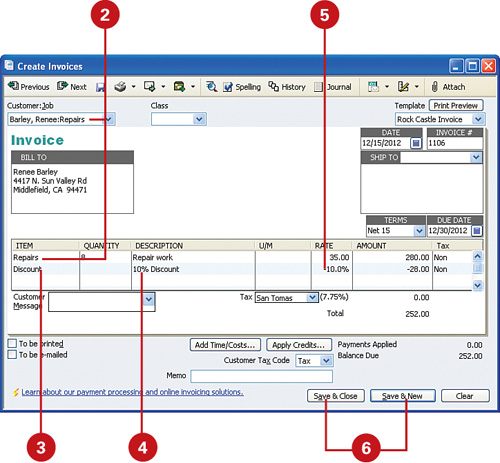
![]() Enter a Discount item in the Item section.
Enter a Discount item in the Item section.
![]() Add a description of the discount, or revise the description that display.
Add a description of the discount, or revise the description that display.
![]() Enter the percent or exact amount of the discount. Enter the percent or amount as a positive number—QuickBooks automatically changes the discount to a negative for you. If you enter a percent, the discount is calculated based on the item on the line above.
Enter the percent or exact amount of the discount. Enter the percent or amount as a positive number—QuickBooks automatically changes the discount to a negative for you. If you enter a percent, the discount is calculated based on the item on the line above.
![]() Save the invoice.
Save the invoice.
Enter a Discount for Early Payment
![]() Select Customers, Receive Payments.
Select Customers, Receive Payments.
Timesaver
Another way to get to the Receive Payments window is to click the Receive Payments icon in the Customers section of the Home page.
![]() Enter the customer’s name.
Enter the customer’s name.
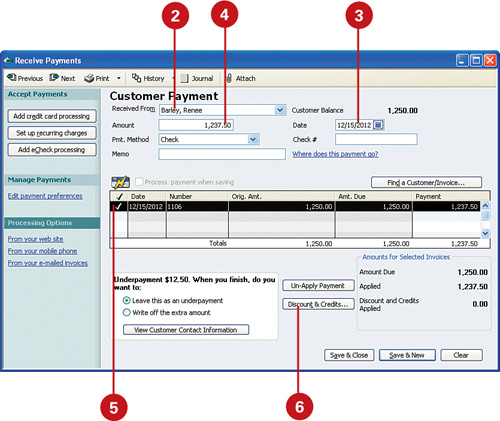
![]() Verify the date on which the payment is received.
Verify the date on which the payment is received.
![]() Enter the amount received.
Enter the amount received.
![]() Click the invoice to which you want to apply a discount.
Click the invoice to which you want to apply a discount.
![]() Click Discount & Credits to open the Discount & Credits window.
Click Discount & Credits to open the Discount & Credits window.
![]() Confirm the discount amount as computed by QuickBooks, and make any necessary changes.
Confirm the discount amount as computed by QuickBooks, and make any necessary changes.
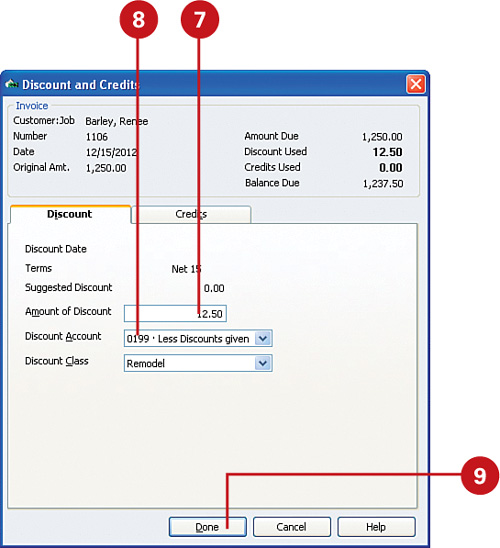
![]() Verify the account to which the discount will be charged.
Verify the account to which the discount will be charged.
![]() Click Done.
Click Done.
![]() Check off the invoice(s) being paid.
Check off the invoice(s) being paid.
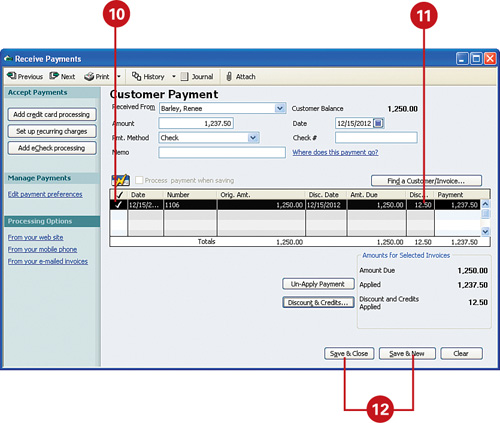
![]() Note that the discount has been applied.
Note that the discount has been applied.
![]() Save the to customer payment screen.
Save the to customer payment screen.
Tracking Accounts Receivable
QuickBooks keeps track of all amounts owed to you by your customers. In addition, QuickBooks produces aging reports to show you how long overdue these outstanding amounts are. Examine these reports frequently so you can keep on top of your company’s collection effectiveness and so you’ll know which customers have trouble making timely payments.
![]() Select Reports, Customers & Receivables, or click the Customers & Receivables option in the Report Center.
Select Reports, Customers & Receivables, or click the Customers & Receivables option in the Report Center.
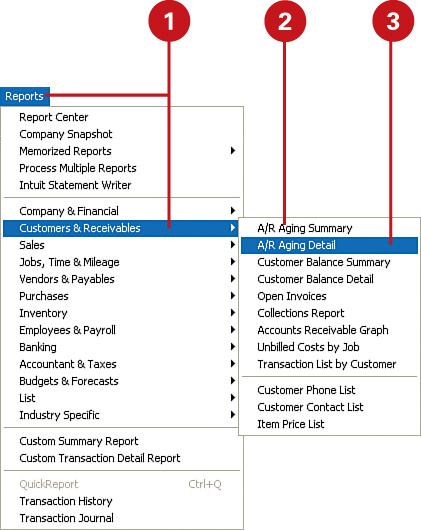
![]() Select A/R Aging Summary to see a list of customers and the amounts owed by them.
Select A/R Aging Summary to see a list of customers and the amounts owed by them.
![]() Select A/R Aging Detail to see every invoice that is overdue.
Select A/R Aging Detail to see every invoice that is overdue.
![]() Double-click any amount on the report to see the actual invoice form.
Double-click any amount on the report to see the actual invoice form.
![]() Press Esc to close the reports.
Press Esc to close the reports.
Viewing the Open Invoices Report
How much is owed to your company and who owes it? This information is readily available on the Open Invoices report. This report shows the detail of all amounts due from every customer and job. Information on this report is grouped by customer and job.
![]() Select Reports, Customers & Receivables; then select Open Invoices from the side menu.
Select Reports, Customers & Receivables; then select Open Invoices from the side menu.
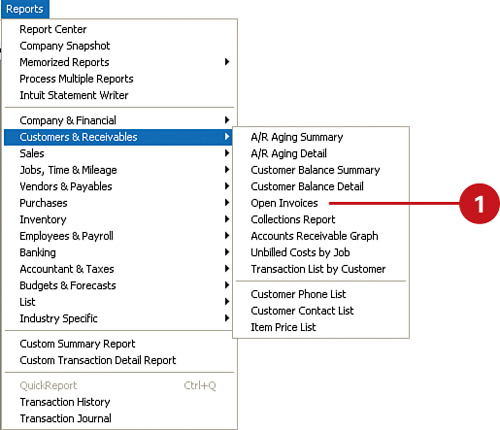
Timesaver
Another way to get to the Open Invoices report is to click the Customers & Receivables option on the Reports Center, and then select Open Invoices.
![]() Click the down arrow if you want to select a different method of sorting the report.
Click the down arrow if you want to select a different method of sorting the report.
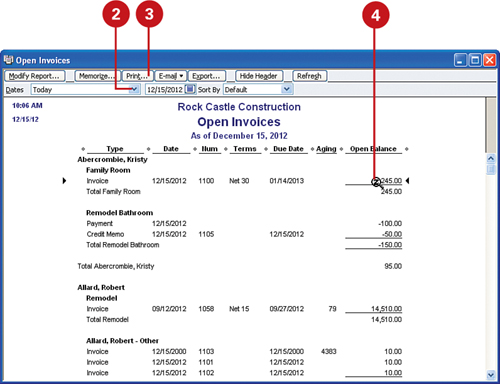
![]() Click Print to print a paper copy of the report.
Click Print to print a paper copy of the report.
![]() Double-click any amount to see the actual invoice.
Double-click any amount to see the actual invoice.
![]() Press Esc to close the report.
Press Esc to close the report.
Creating a Collection Letter
Of course, you can open your word processing program and write an extemporaneous letter to the customer who owes you money. Or you can save time and use a standard form letter that is available to send to any customers who owe you money, anytime. Before printing the letters, you have the capability to customize the letters and add personal information if necessary.
![]() Select Company, Prepare Letters with Envelopes; then select the type of letter you want to create. For this example, a collection letter is selected.
Select Company, Prepare Letters with Envelopes; then select the type of letter you want to create. For this example, a collection letter is selected.
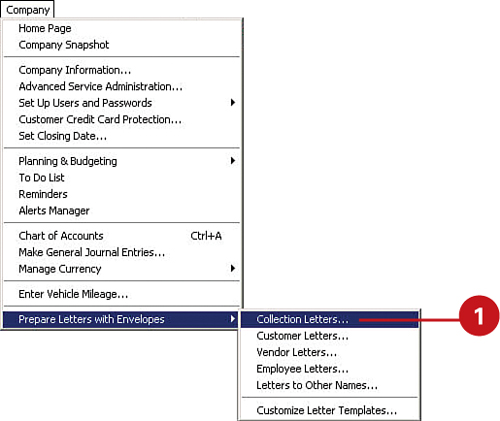
![]() Select from the various options to determine who will receive this letter.
Select from the various options to determine who will receive this letter.
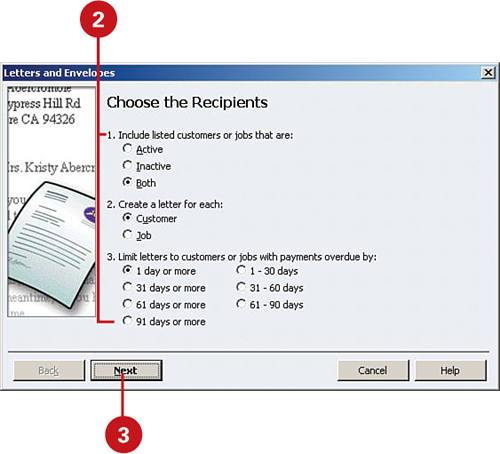
![]() Click Next.
Click Next.
![]() Choose to sort your list alphabetically by customer name or by amount, lowest to highest.
Choose to sort your list alphabetically by customer name or by amount, lowest to highest.
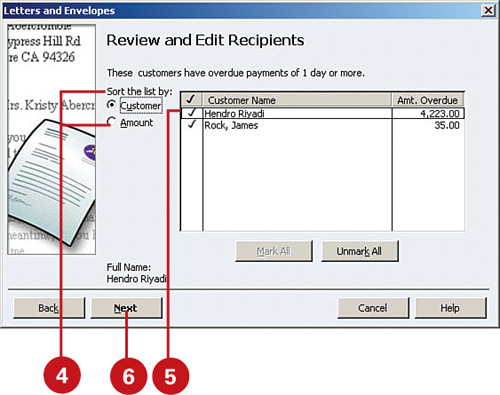
![]() The list that display here is the result of the selections you made in Step 2. Check off all members of the list who will receive the letter. Use the Mark All and Unmark All buttons to help with your selections.
The list that display here is the result of the selections you made in Step 2. Check off all members of the list who will receive the letter. Use the Mark All and Unmark All buttons to help with your selections.
![]() Click Next.
Click Next.
![]() Choose from a variety of available letters, or click the Create or Edit a Letter Template option to customize your mailing. If you choose to create a letter from scratch, a Microsoft Word document where you can customize your letter will appear. For this example, the Friendly Collection letter template has been chosen.
Choose from a variety of available letters, or click the Create or Edit a Letter Template option to customize your mailing. If you choose to create a letter from scratch, a Microsoft Word document where you can customize your letter will appear. For this example, the Friendly Collection letter template has been chosen.
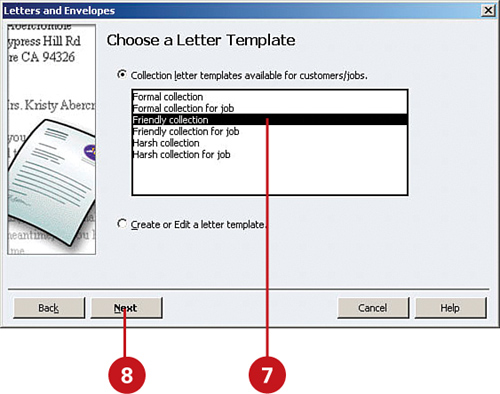
![]() Click Next.
Click Next.
![]() Enter the name and title of the person who will sign the letters.
Enter the name and title of the person who will sign the letters.
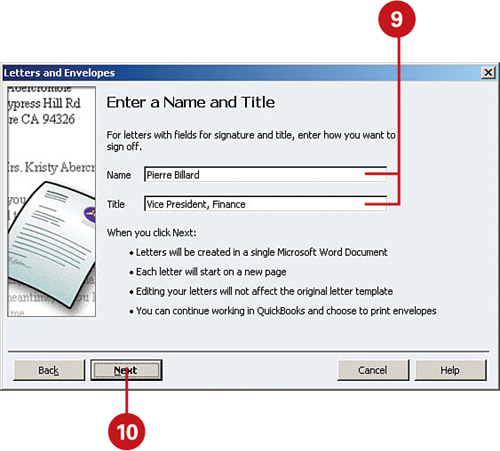
![]() Click Next. A Microsoft Word document containing all the letters will open.
Click Next. A Microsoft Word document containing all the letters will open.
![]() Scroll through the letters to make sure they read the way you want them to. If necessary, you can add information to any letter.
Scroll through the letters to make sure they read the way you want them to. If necessary, you can add information to any letter.
![]() Select File, Print from the Word menu bar.
Select File, Print from the Word menu bar.
![]() In QuickBooks, click Next if you want to print envelopes. If you choose this option, you are asked to verify the size of the envelopes. In the Microsoft Word document that display, click OK to print the envelopes.
In QuickBooks, click Next if you want to print envelopes. If you choose this option, you are asked to verify the size of the envelopes. In the Microsoft Word document that display, click OK to print the envelopes.
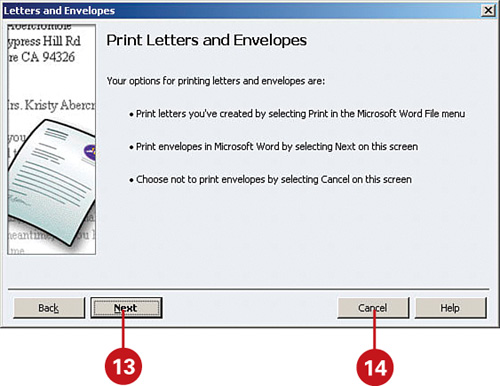
![]() If you don’t want to print envelopes, click Cancel.
If you don’t want to print envelopes, click Cancel.
![]() In QuickBooks, click Finish to close the Letters and Envelopes window.
In QuickBooks, click Finish to close the Letters and Envelopes window.
Recording Bad Debts
If your company keeps records on an accrual basis, you’ve already recorded income when a job is completed and invoiced, even though you haven’t yet received the payment from your customer. So when you discover that the customer isn’t going to pay, you need to offset the income you recorded with a bad debt expense.
![]() Select Customers, Receive Payments, or click the Receive Payments icon on the QuickBooks Home page.
Select Customers, Receive Payments, or click the Receive Payments icon on the QuickBooks Home page.
![]() Enter the name of the customer and job, if applicable, for whom you will record a bad debt.
Enter the name of the customer and job, if applicable, for whom you will record a bad debt.
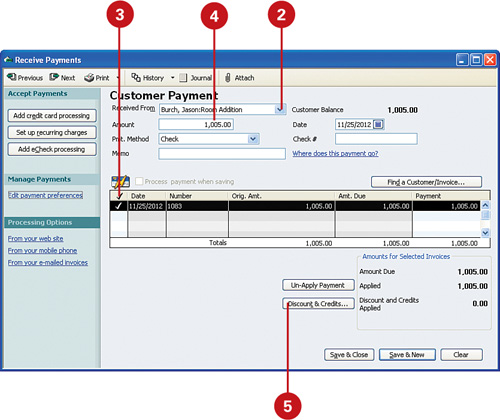
![]() Click to place a check mark to the left of an uncollectible invoice.
Click to place a check mark to the left of an uncollectible invoice.
![]() QuickBooks will pre-fill the Amount box with the remaining amount due for the selected invoice.
QuickBooks will pre-fill the Amount box with the remaining amount due for the selected invoice.
![]() Click the Discounts & Credits button.
Click the Discounts & Credits button.
![]() Enter as a discount the amount of the uncollectible debt.
Enter as a discount the amount of the uncollectible debt.
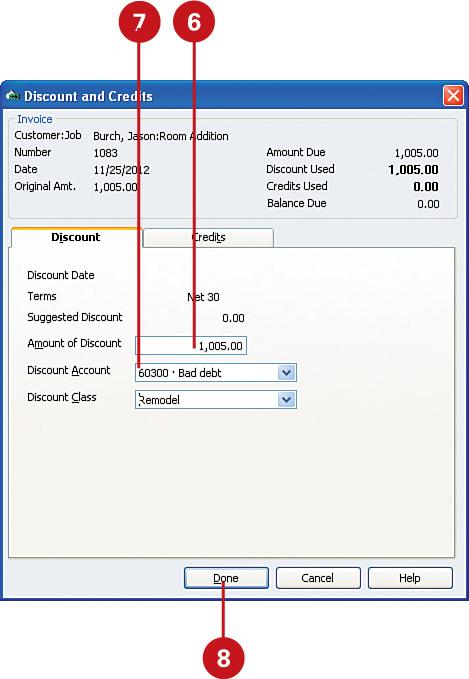
![]() If necessary, change the discount account field to reflect the account where you record bad debt expenses.
If necessary, change the discount account field to reflect the account where you record bad debt expenses.
![]() Click the Done button.
Click the Done button.
![]() Save the Receive Payments window.
Save the Receive Payments window.
Working with Multiple Currencies
Today, business economy is ever changing and for many businesses that means reaching into the global economy to conduct business. If your business buys or sells its products or services in a currency different from your home currency, then you will benefit from using the Multicurrency feature in QuickBooks.
To begin using Multiple Currencies in QuickBooks you first enable the feature, a task that cannot be reversed. To keep your financial records current you use the exchange rate download and home currency adjustment tools. Your home currency is the currency of the country where your business is located. Using this feature, you can report your business financials in your home-based currency as well as foreign currencies.
Important
Before you begin using Multiple Currency features in QuickBooks, review the information available in the Intuit Community. To access this information, select Manage Currency from the Company menu and then choose the Multicurrency Resource option on the right (Internet connection required).
Enable Multiple Currency in QuickBooks
![]() From the Edit menu, select Preferences and choose the Multiple Currencies option.
From the Edit menu, select Preferences and choose the Multiple Currencies option.
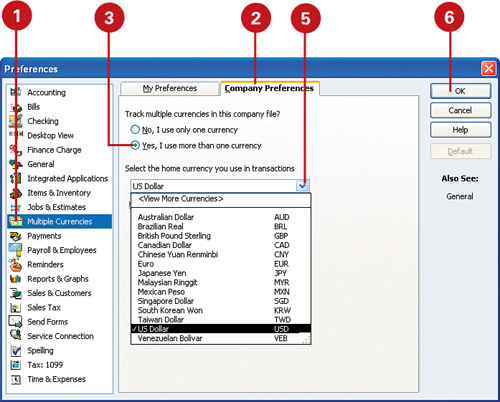
![]() Select the Company Preferences tab.
Select the Company Preferences tab.
![]() Click Yes, I use more than one currency.
Click Yes, I use more than one currency.
![]() Click Yes to the warning that you are enabling multicurrency in your data file
Click Yes to the warning that you are enabling multicurrency in your data file
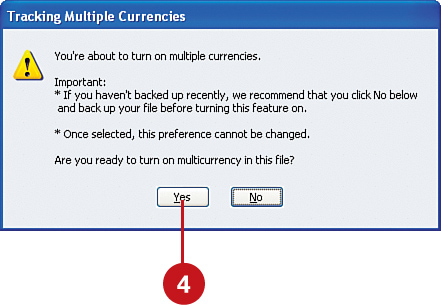
Important
The preference to enable Multiple Currency affects your financial reporting and cannot be disabled, so make sure you have made a backup of your data file prior to selecting this option. If you have an existing business, it is also advisable to discuss this change with your accounting professional.
![]() Select your home currency from the drop-down menu options.
Select your home currency from the drop-down menu options.
![]() Click OK to close the Preferences dialog.
Click OK to close the Preferences dialog.
![]() Click OK to the warning (not shown) that your company file will close and reopen with the changes made.
Click OK to the warning (not shown) that your company file will close and reopen with the changes made.
Assign a Currency to Your Foreign Customer or Vendor
![]() From the Icon bar select Customer Center (not shown).
From the Icon bar select Customer Center (not shown).
![]() Click on New Customer (not shown).
Click on New Customer (not shown).
![]() Type a Customer Name.
Type a Customer Name.

![]() From the Currency drop-down, select the default currency to use for this customer.
From the Currency drop-down, select the default currency to use for this customer.
![]() Enter additional customer information as needed.
Enter additional customer information as needed.
![]() Click OK.
Click OK.
![]() From the icon bar select Vendor Center (not shown).
From the icon bar select Vendor Center (not shown).
![]() Click on New Vendor (not shown).
Click on New Vendor (not shown).
![]() Type a Vendor Name.
Type a Vendor Name.

![]() From the Currency drop-down, select the default currency to use for this vendor.
From the Currency drop-down, select the default currency to use for this vendor.
![]() Enter additional vendor information as needed.
Enter additional vendor information as needed.
![]() Click OK.
Click OK.
Important
You will assign the default currency to your customer and vendor records so that the correct currency will default on their respective transactions. If your customer or vendor has had transaction activity before using the multicurrency feature, you will have to create a new customer or vendor record for the foreign activity.
Select the Foreign Currencies You Will Be Using
![]() From the Company menu, select Manage Currency.
From the Company menu, select Manage Currency.
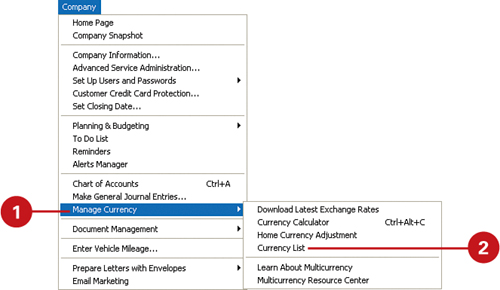
![]() Select Currency List.
Select Currency List.
![]() If you are adding or removing a currency, click Include Inactive.
If you are adding or removing a currency, click Include Inactive.

![]() Scroll through the list of exchange currencies.
Scroll through the list of exchange currencies.
![]() With your mouse click to remove the “x” in front of a currency to make it available for use or click to add the “x” to a list item to make it inactive.
With your mouse click to remove the “x” in front of a currency to make it available for use or click to add the “x” to a list item to make it inactive.
![]() When you have finished selecting the currencies you want to work with, uncheck Include Inactive to shorten the list of currencies displayed in the list view.
When you have finished selecting the currencies you want to work with, uncheck Include Inactive to shorten the list of currencies displayed in the list view.

![]() Click the red (x) on the top right of the Currency List to close.
Click the red (x) on the top right of the Currency List to close.
Add Foreign Chart of Accounts
![]() From the List menu, select Chart of Accounts and choose New from the Account drop-down menu (not shown).
From the List menu, select Chart of Accounts and choose New from the Account drop-down menu (not shown).
![]() Select Bank or Credit Card from the Add New Account: Choose Account Type dialog (not shown). QuickBooks automatically creates the necessary foreign Accounts Receivable and Accounts Payable accounts when the foreign currency is used on a transaction.
Select Bank or Credit Card from the Add New Account: Choose Account Type dialog (not shown). QuickBooks automatically creates the necessary foreign Accounts Receivable and Accounts Payable accounts when the foreign currency is used on a transaction.
![]() Click Continue.
Click Continue.
![]() Enter your new account Number, if the accounting numbering preference is enabled.
Enter your new account Number, if the accounting numbering preference is enabled.
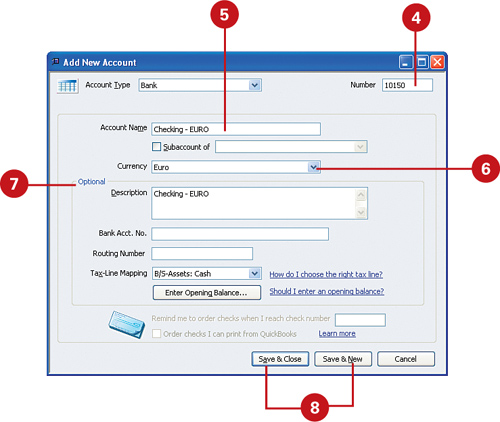
![]() Type an Account Name.
Type an Account Name.
![]() Select the appropriate currency from the Currency drop-down list.
Select the appropriate currency from the Currency drop-down list.
![]() Enter the optional information as needed.
Enter the optional information as needed.
![]() Click a Save option.
Click a Save option.
Update the Foreign Exchange Rates
![]() From the Company menu, select Manage Currency.
From the Company menu, select Manage Currency.
![]() Select Download Latest Exchange Rates. You can also access this functionality from the Currency List menu, Activities menu.
Select Download Latest Exchange Rates. You can also access this functionality from the Currency List menu, Activities menu.
![]() Click OK to the message (not shown) that QuickBooks successfully updated the exchange rates
Click OK to the message (not shown) that QuickBooks successfully updated the exchange rates
![]() Click OK to the message (not shown) that the rates downloaded successfully.
Click OK to the message (not shown) that the rates downloaded successfully.
![]() You can edit the exchange rate by selecting a currency from the Currency drop-down menu and then choosing Edit Currency.
You can edit the exchange rate by selecting a currency from the Currency drop-down menu and then choosing Edit Currency.
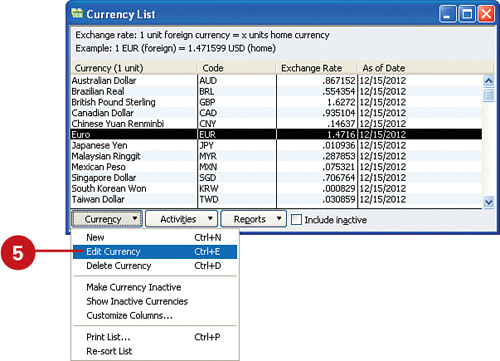
![]() Click the Change Format (not shown) to modify how the currency displays, click OK (not shown) to return to the Edit Currency dialog.
Click the Change Format (not shown) to modify how the currency displays, click OK (not shown) to return to the Edit Currency dialog.
![]() Browse through the displayed calendar to select a date for the new exchange rate.
Browse through the displayed calendar to select a date for the new exchange rate.
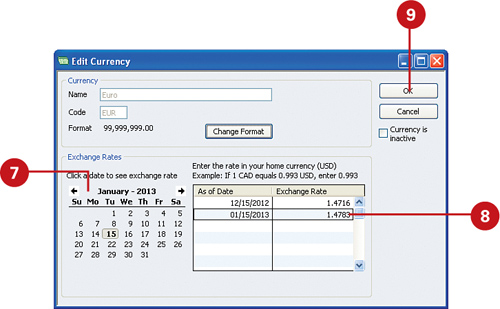
![]() In the Exchange Rate column enter the appropriate rate.
In the Exchange Rate column enter the appropriate rate.
![]() Click OK.
Click OK.
Record Foreign Sales Transactions
![]() To create a customer invoice, from the Home Page (not shown) click on Invoices.
To create a customer invoice, from the Home Page (not shown) click on Invoices.
![]() Select your foreign customer.
Select your foreign customer.

![]() The default currency Accounts Receivable account is selected.
The default currency Accounts Receivable account is selected.
![]() Confirm the date and invoice number assigned by default are correct.
Confirm the date and invoice number assigned by default are correct.
![]() Enter the item or items being sold to the customer.
Enter the item or items being sold to the customer.
![]() The Exchange Rate as of the date assigned to the customer invoice is displayed. Accept the default exchange rate (recommended) or modify as needed.
The Exchange Rate as of the date assigned to the customer invoice is displayed. Accept the default exchange rate (recommended) or modify as needed.
![]() The Balance Due is displayed in both the home currency and the foreign currency.
The Balance Due is displayed in both the home currency and the foreign currency.
![]() Click a Save option.
Click a Save option.
![]() Click, Receive Payments on the Home Page (not shown) to receive payments from the foreign customer.
Click, Receive Payments on the Home Page (not shown) to receive payments from the foreign customer.
![]() Select the foreign Customer.
Select the foreign Customer.
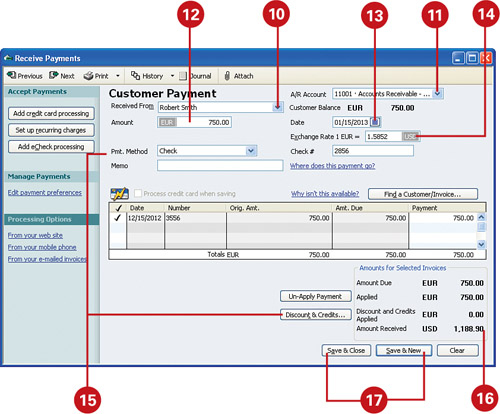
![]() QuickBooks will display the default A/R Account or you can select a different account.
QuickBooks will display the default A/R Account or you can select a different account.
![]() Enter the foreign currency Amount received or change if needed.
Enter the foreign currency Amount received or change if needed.
![]() Select the Date the funds were received.
Select the Date the funds were received.
![]() Confirm the default Exchange Rate for the selected date is correct, or edit if needed.
Confirm the default Exchange Rate for the selected date is correct, or edit if needed.
![]() Complete the remaining information.
Complete the remaining information.
![]() Verify that the calculated Amount Received agrees with your banking records.
Verify that the calculated Amount Received agrees with your banking records.
![]() Click a Save option.
Click a Save option.
Record Foreign Purchase Transactions
![]() To create a vendor bill, from the Home Page (not shown) click on Enter Bills.
To create a vendor bill, from the Home Page (not shown) click on Enter Bills.
![]() Select your vendor.
Select your vendor.
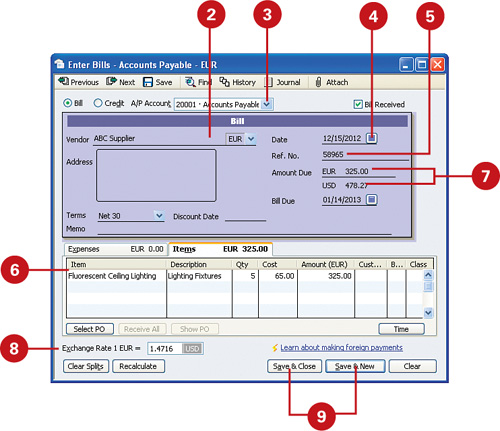
![]() Confirm the default currency Accounts Payable account assigned to your New or Edit vendor record.
Confirm the default currency Accounts Payable account assigned to your New or Edit vendor record.
![]() Enter the Date you want to record for the vendor bill.
Enter the Date you want to record for the vendor bill.
![]() Enter the vendor’s bill number in the Ref. No. field.
Enter the vendor’s bill number in the Ref. No. field.
![]() Enter the item or items being purchased from the vendor.
Enter the item or items being purchased from the vendor.
![]() The Amount Due displays both the foreign currency and home currency cost for the exchange rate as of the bill date.
The Amount Due displays both the foreign currency and home currency cost for the exchange rate as of the bill date.
![]() Accept the default exchange rate (recommended) or modify as needed.
Accept the default exchange rate (recommended) or modify as needed.
![]() Click a Save option.
Click a Save option.
![]() Click Pay Bills on the Home Page (not shown) to pay the vendor bill.
Click Pay Bills on the Home Page (not shown) to pay the vendor bill.
![]() Select to Show All Bills, or only bills due on or before a specific date.
Select to Show All Bills, or only bills due on or before a specific date.

![]() Select the A/P Account for the foreign vendor.
Select the A/P Account for the foreign vendor.
![]() Filter or sort the Pay Bills listing as desired.
Filter or sort the Pay Bills listing as desired.
![]() Select the bills to be paid.
Select the bills to be paid.
![]() Complete the remaining information.
Complete the remaining information.
![]() Verify the correct Exchange Rate is listed for your bill payment date. Modify as needed.
Verify the correct Exchange Rate is listed for your bill payment date. Modify as needed.
![]() Click Pay Selected Bills.
Click Pay Selected Bills.
Prepare Unrealized Gains and Losses Report
![]() To prepare an Unrealized Gains & Losses report, select Reports, Company & Financial from the menu bar.
To prepare an Unrealized Gains & Losses report, select Reports, Company & Financial from the menu bar.
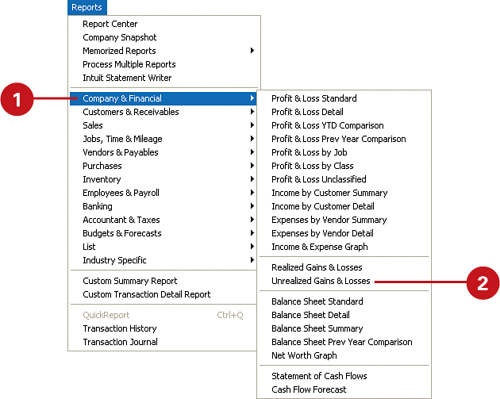
![]() Select Unrealized Gains & Losses report.
Select Unrealized Gains & Losses report.
![]() In the Enter Exchange Rates dialog that displays, select the date you want to report the Unrealized Gains and Losses for.
In the Enter Exchange Rates dialog that displays, select the date you want to report the Unrealized Gains and Losses for.

![]() If the proper Exchange Rate does not default, enter the appropriate rate for the selected date.
If the proper Exchange Rate does not default, enter the appropriate rate for the selected date.
![]() Click Continue.
Click Continue.
Important
You can assure that your financials are properly reported with the correct exchange rate if you make it a daily task to download or manually enter the updated exchange rates. See the previous section titled “Update the Foreign Exchange Rates.”
![]() The Unrealized Gains & Losses report is displayed and for each currency with unpaid transactions, the rate used for the report is displayed.
The Unrealized Gains & Losses report is displayed and for each currency with unpaid transactions, the rate used for the report is displayed.
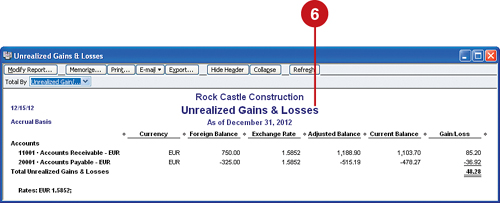
Prepare Realized Gains and Losses Report
![]() To prepare a Realized Gains & Losses report, select Reports, Company & Financial from the menu bar (not shown).
To prepare a Realized Gains & Losses report, select Reports, Company & Financial from the menu bar (not shown).
![]() Select Realized Gains & Losses to display the report showing transaction details of the recognized gain or loss on the reporting transactions.
Select Realized Gains & Losses to display the report showing transaction details of the recognized gain or loss on the reporting transactions.
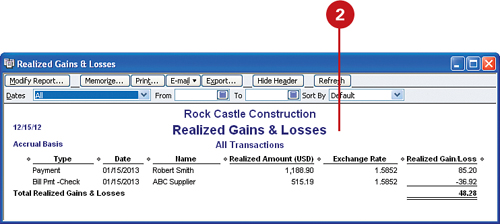
![]() View your Profit & Loss, by selecting Reports, Company & Financial and selecting Profit & Loss Standard.
View your Profit & Loss, by selecting Reports, Company & Financial and selecting Profit & Loss Standard.
![]() Change the dates if needed.
Change the dates if needed.
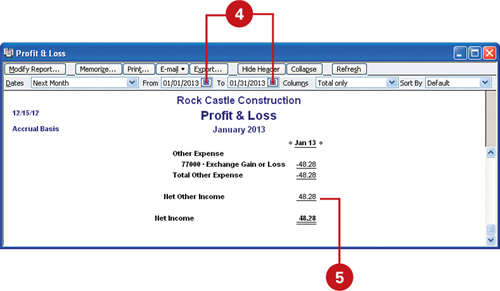
![]() View the Exchange Gain or Loss amount reported on the Profit & Loss and compare to the Realized Gains & Losses report prepared above.
View the Exchange Gain or Loss amount reported on the Profit & Loss and compare to the Realized Gains & Losses report prepared above.
Make a Home Currency Adjustment
![]() To restate your business financials in the home currency as of a specific date range, click Company, Manage Currency (not shown) and choose the Home Currency Adjustment.
To restate your business financials in the home currency as of a specific date range, click Company, Manage Currency (not shown) and choose the Home Currency Adjustment.
![]() The Home Currency Adjustment dialog displays. Select the date for which you are restating your financial statements.
The Home Currency Adjustment dialog displays. Select the date for which you are restating your financial statements.

![]() Select Currency from the drop-down menu.
Select Currency from the drop-down menu.
![]() The default Exchange Rate displays; if needed it can be modified here.
The default Exchange Rate displays; if needed it can be modified here.
![]() Click Calculate Adjustment.
Click Calculate Adjustment.
![]() Click Select All (recommended) or choose individual transactions to include in the Home Currency Adjustment.
Click Select All (recommended) or choose individual transactions to include in the Home Currency Adjustment.
![]() Click a Save option.
Click a Save option.
![]() QuickBooks restates your foreign Balance Sheet accounts in the value of the home currency and posts the offsetting entry to an Other Expense type account named “Exchange Gain or Loss.”
QuickBooks restates your foreign Balance Sheet accounts in the value of the home currency and posts the offsetting entry to an Other Expense type account named “Exchange Gain or Loss.”
